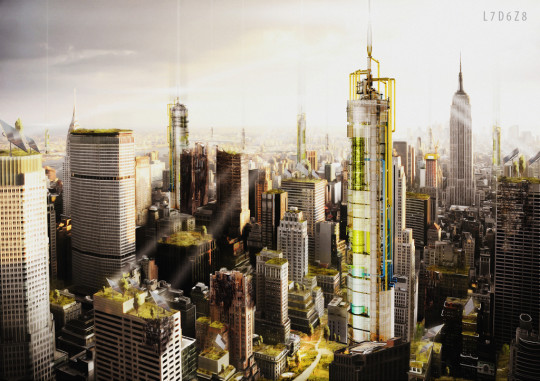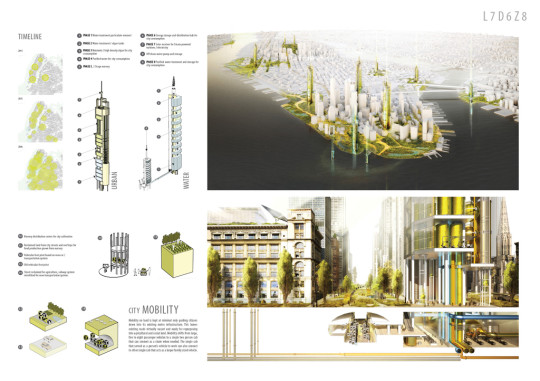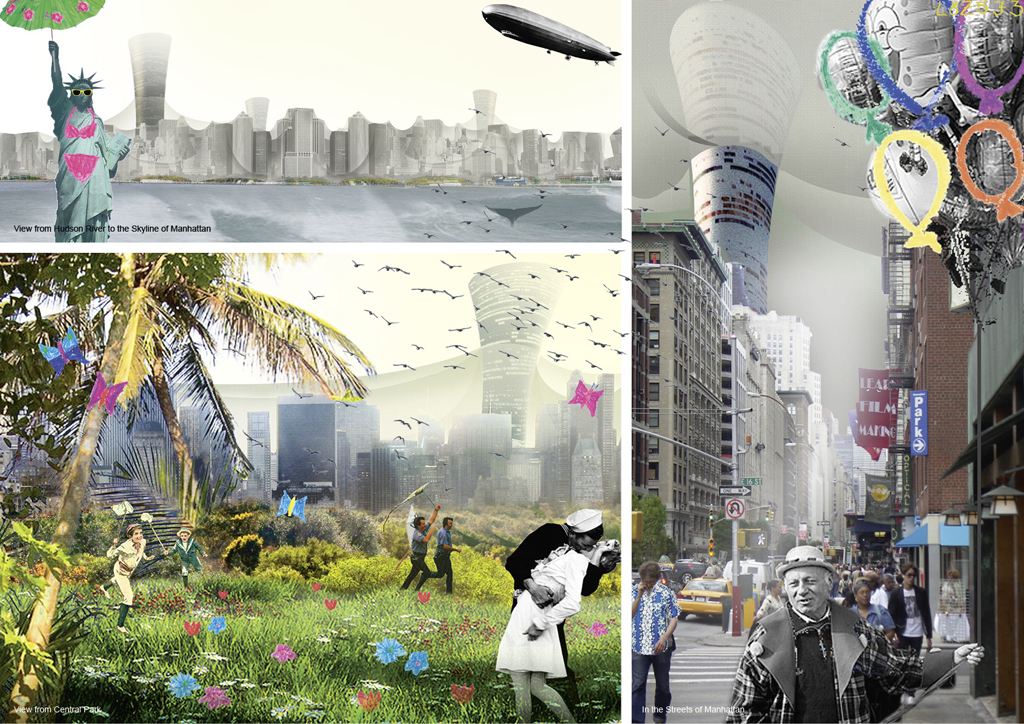Info:
Title: New York - Code: L7D6Z8Contest: NY / 2012
By: J. Vierra - P. Austin
Views: 2569 Likes: 1
Votes:
JOSHUA PRINCE-RAMUS3 EVA FRANCH I GILABERT3 ROLAND SNOOKS0 SHOHEI SHIGEMATSU4 ALESSANDRO ORSINI1 MITCHELL JOACHIM12.0
New York

 Parallel to technological advances, we see a decline in the quality of life along with a regression in healthy viable resources like food, water, air and energy. Not coincidently we see a degradation of the social fabric that once held cultures together in a tight knit fashioned. Manhattanhas a well-established infrastructural system suitable for moving its population and distributing resources from one location to the next. Miles of subway tunnels, pipes, and conduits stretch across the city in all directions, forming a complex arterial network. The proposed design augments this existing framework by creating regional epicenters that produce and distribute vital resources. These epicenters, integrate within the existing context, seamlessly providing resources and services to the residents of the city.
Parallel to technological advances, we see a decline in the quality of life along with a regression in healthy viable resources like food, water, air and energy. Not coincidently we see a degradation of the social fabric that once held cultures together in a tight knit fashioned. Manhattanhas a well-established infrastructural system suitable for moving its population and distributing resources from one location to the next. Miles of subway tunnels, pipes, and conduits stretch across the city in all directions, forming a complex arterial network. The proposed design augments this existing framework by creating regional epicenters that produce and distribute vital resources. These epicenters, integrate within the existing context, seamlessly providing resources and services to the residents of the city.
Water is not an autonomous resource. The quality, quantity, and availability of this vital resource is directly affected by the environmental condition from which it comes. The epicenters harvest and purify water from storm / gray water sources, as well as nearby lake reservoirs. Purification occurs in several phases: first, particulate matter is removed, then algae treatment, and lastly extreme heat. This allows for a clean, supplementary source of water, while also reclaiming waste that can be re-used as nutrients within other systems of a typical tower.
Energy is locally produced in a clean and efficient manner. Automated sun-tracking mirrors are located on adjacent roof tops to concentrate a sufficient surface area of sun energy into a single point on the tower. This heating element is combined with water to convert into steam, necessary to power electrical turbines. Power not going directly to the grid is stored.
Water purification and energy creation fuel the production of highly-concentrated plant nurseries. Algae, minerals, and other by-products associated with water treatment are used as agricultural fertilizer, flourishing within the perfect environment created by clean water and the solar phase. The distribution of nursery-raised plants is governed by an “on-demand” system, where citizens collect food-bearing plants as needed at the base of the tower and raise them throughout the city, providing a daily, direct connection with the food being consumed.
Aiding these new processes is a reduction of the transportation systems foot print in the city preserving the valued land and potential resources for it to produce. This leaves existing roads virtually vacant and ready for repurposing into agricultural and social land. Mobility shifts from large, five to eight passenger vehicles to a single two person cab that can connect as a chain when needed. The single cab that served as a person’s vehicle to work in the morning can connect to two more cabs in the evening supporting their family of six.
These basic principles work in sync to achieve a complete interdisciplinary service based tower where the process of one resource aides in the production of another, creating an efficient loop within itself and the surround context.
Citizens living in and around these new cultural and resource-based epicenters will learn to understand the concept of regional limitations. Constant physical and visual interactions with the life-giving towers will reintroduce and reinforce the concept of limited resource availability. Despite the unyielding demand for additional resource and energy production, a new balance will be achieved, one in which consumption and a given region’s ability to reciprocate will again be intrinsically linked. Resources are finite and the success of the city will depends on its ability to live within its regional means.






